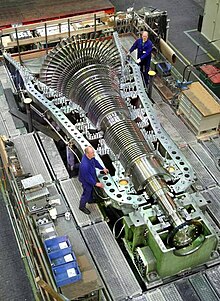Turbomachinery, in mechanical engineering, describes machines that transfer energy between a rotor and a fluid, including both turbines and compressors. While a turbine transfers energy from a fluid to a rotor, a compressor transfers energy from a rotor to a fluid. The two types of machines are governed by the same basic relationships including Newton's second Law of Motion and Euler's energy equation for compressible fluids. Centrifugal pumps are also turbomachines that transfer energy from a rotor to a fluid, usually a liquid, while turbines and compressors usually work with a gas.[1]
Contents[hide] |
[edit] Classification

A steam turbine from MAN SE subdidiary MAN Turbo
Turbomachines are also categorized according to the type of flow. When the flow is parallel to the axis of rotation, they are called axial flow machines, and when flow is perpendicular to the axis of rotation, they are referred to as radial (or centrifugal) flow machines. There is also a third category, called mixed flow machines, where both radial and axial flow velocity components are present.
Turbomachines may be further classified into two additional categories: those that absorb energy to increase the fluid pressure, i.e. pumps, fans, and compressors, and those that produce energy such as turbines by expanding flow to lower pressures. Of particular interest are applications which contain pumps, fans, compressors and turbines. These components are essential in almost all mechanical equipment systems, such as power and refrigeration cycles.[2]
Classification of fluid machinery in species and groups
| machine type → group ↓ | machinery | combinations of power and machinery | engines |
|---|---|---|---|
| open turbomachine | propeller | wind turbines | |
| hydraulic fluid machinery (≈ incompressible fluids) | centrifugal pumps turbopumps and fans | Fluid couplings and clutches (hydrodynamic gearbox); Voith Turbo-Transmissions; pump-turbines (in pumped-storage hydroelectricity) | water turbines |
| thermal turbomachinery (compressible fluid) | compressors | gas turbines (inlet of GT consists of a compressor) | steam turbines ← turbine jet engines |
[edit] Dimensionless ratios to describe turbomachinery

A pelton wheel turbine wheel being installed into power generation equipment
- Pressure range ψ
- Flow number φ (including delivery or volume number called)
- Performance numbers λ
- Run number σ
- Diameter Number δ
Tidak ada komentar:
Posting Komentar